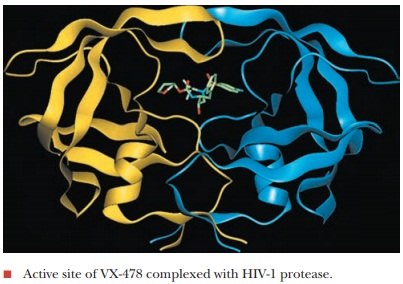Chapter: Biochemistry: The Behavior of Proteins: Enzymes
Enzyme Inhibition in the Treatment of AIDS
Enzyme Inhibition in the
Treatment of AIDS
A key
strategy in the treatment of acquired immunodeĂžciency syndrome (AIDS) has been
to develop speciĂžc inhibitors that selectively block the actions of enzymes
unique to the human immunodeĂžciency virus (HIV), which causes AIDS. Many
laboratories are working on this approach to the development of therapeutic
agents. Three key enzymes are current targets for AIDS therapyÑreverse transcriptase,
integrase, and protease.
One of
the most important target enzymes is HIV protease, an enzyme essential to the
production of new virus particles in infected cells. HIV protease is unique to
this virus. It catalyzes the processing of viral proteins in an infected cell.
Without these proteins, viable virus particles cannot be released to cause
further infection. The structure of HIV protease, including its active site,
was known from the results of X-ray crystallography. With this structure in
mind, scientists have designed and synthesized compounds to bind to the active
site. Improvements were made in the drug design by obtaining structures of a series
of inhibitors bound to the active site of HIV protease. These structures were
also elucidated by X-ray crystallography. This process eventually led to
several compounds marketed by different pharmaceutical companies. These HIV
protease inhibitors include saquinavir from Hoffman-LaRoche, ritonavir from
Abbott Laboratories, indinavir from Merck, Viracept from Pfizer, and amprenavir
from Vertex Pharmaceuticals. (These companies maintain highly infor-mative home
pages on the World Wide Web.)
The most
recent target is the viral enzyme called integrase, which is needed for the
virus to copy itself in the host cell. A recent drug made by Merck, called
MK-0518, inhibits the inte-grase enzyme. Treatment of AIDS is most effective
when a combi-nation of drug therapies is used, and HIV protease, integrase, and
reverse transcriptase inhibitors play an important role. The use of multiple
inhibitors for the key viral enzymes allows levels of each to remain below
toxic levels to the cell.

Related Topics